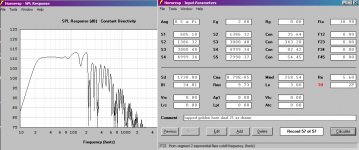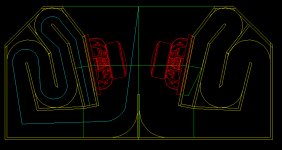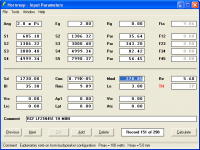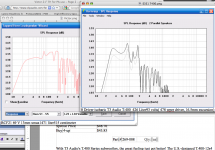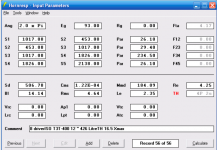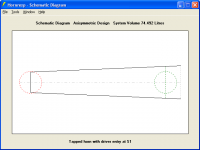I am designing a new sub for an area nightclub with an eye for use as a mobile sub for larger concert use as well. I 'think' I'm close to sawdust but would love to have the model looked over & commented on by some of the gurus here from whom I've learned so much as a reading but not posting member...I generally try to keep my mouth shut until I have something useful to say 🙂
The club in question has been bringing in high-end electronica & dub DJs as well as local bands. Their existing subs are woefully inadequate, consisting of two EV QRx118s driven by a QSC RMX2450. On larger shows they rent some of my mobile rig to augment, typically four CV T36/750 subs driven by a pair of QSC PL3602.
As I run the shows, I often monitor the rig with smaart to get a feel for the frequency content that is lacking in addition to the raw output levels we need so we can 'overprovide' in the proposed upgrade.
It is common for the DJs to include frequency sweeps in the material in addition to the kick pulses. The kicks are pretty normal in content, usually centering in the 38-50Hz range depending on the song & performer. The sweeps however always drop to at least 30Hz and sometimes go as low as 22Hz before signal level drops.
I'm naming this design after my uncle, a watchmaker who taught me much about small business customer ethics & how to treat people, hence 'Victor'.
Comments and improvements are welcome and encouraged, that's why I'm posting this. I have also modeled it as a single 21 cab by splitting it down the middle into two 4x4x2 boxes for large mobile purposes. I consider this design proprietary for commercial purposes, anyone is welcome to build them for their own personal use (including use in your own PA) but you don't build them for resale.
This is what I've come up with using two RCF LF21N451 drivers:
The club in question has been bringing in high-end electronica & dub DJs as well as local bands. Their existing subs are woefully inadequate, consisting of two EV QRx118s driven by a QSC RMX2450. On larger shows they rent some of my mobile rig to augment, typically four CV T36/750 subs driven by a pair of QSC PL3602.
As I run the shows, I often monitor the rig with smaart to get a feel for the frequency content that is lacking in addition to the raw output levels we need so we can 'overprovide' in the proposed upgrade.
It is common for the DJs to include frequency sweeps in the material in addition to the kick pulses. The kicks are pretty normal in content, usually centering in the 38-50Hz range depending on the song & performer. The sweeps however always drop to at least 30Hz and sometimes go as low as 22Hz before signal level drops.
I'm naming this design after my uncle, a watchmaker who taught me much about small business customer ethics & how to treat people, hence 'Victor'.
Comments and improvements are welcome and encouraged, that's why I'm posting this. I have also modeled it as a single 21 cab by splitting it down the middle into two 4x4x2 boxes for large mobile purposes. I consider this design proprietary for commercial purposes, anyone is welcome to build them for their own personal use (including use in your own PA) but you don't build them for resale.
This is what I've come up with using two RCF LF21N451 drivers:
Attachments
Any reason for all the angled boards? Just seems Like bracing becomes more complicated with it set up like that.
The sim looks good. Is that 1 watt though? 5.6 ohms per driver and 2 Volts...
The sim looks good. Is that 1 watt though? 5.6 ohms per driver and 2 Volts...
The 45 degree caps are sort of serendipitous, I don't like to have much negative space in a cabinet design, and after drawing them it literally just happened that it exactly matched the front profile of the existing stage in the club. As for the other angled boards, since I'm doing CNC for all the routing, why not have technically correct flares?
RCF calls the driver an 8 ohm device, so with two in parallel I set Hornresp to 1W at 4 ohm. In the club in question, the plan is to drive the sub with their existing QSC RMX 2450.
RCF calls the driver an 8 ohm device, so with two in parallel I set Hornresp to 1W at 4 ohm. In the club in question, the plan is to drive the sub with their existing QSC RMX 2450.
RCF calls the driver an 8 ohm device, so with two in parallel I set Hornresp to 1W at 4 ohm. In the club in question, the plan is to drive the sub with their existing QSC RMX 2450.
Those angles, though harder to build, will stiffen things up a bit if you can get the shallow angles to hold together, pocket screws would work.
The cabinet minimum impedance is near the DCR, the cabinet is 2.8 ohms, not 4.
The 1/8 space response (.5 Pi in Hornresp) is generally unrealistic in most rooms, and exaggerates the LF response.
When modeled in half space (2pi in Hornresp) the Victor hits Xmax at 69 volts (about 2070 watts) and can do about 132 dB at 80 Hz, 130 dB at 27 Hz, an F3 of about 21 Hz.
Running only a peak power of around 1000 watts per driver should keep the thermal compression pretty minimal.
At 1471.8 liters (52 cubic feet of interior space) it is a big cabinet, well over 3 times the size of the B&C18SW115-4 loaded 18" TH I built, a pair of which can do about 136 dB down to 37 Hz, around 140 dB in the 80 Hz range.
That is a big difference where most of the sub booty lives.
I do like that you kept the cabinet depth relatively shallow.
You may want to think of a redesign to get the F3 to 27-30 Hz or so to get the SPL up, even with dubstep there does not seem to be much content below 30 Hz.
Art
Maybe some helpful stuff from Josh Ricci's thread on the Gjallerhorn...it's a similarly sized cabinet, with a similar 20ish Hz response!
http://www.diyaudio.com/forums/subwoofers/189784-gjallerhorn.html
http://www.diyaudio.com/forums/subwoofers/189784-gjallerhorn.html
weltersys: whoops & thank you...I had completely missed that I was modeling that in 1/8 space...very different response from my intended 1/2 space! I don't know at what point in the process that happened, but I sensed I must be missing something as the projection looked too good to be true...I'm diving into the process again
More comments are welcome, I'm learning as I go but stand embarrassed at that oversight...
More comments are welcome, I'm learning as I go but stand embarrassed at that oversight...
Hi Trackzilla.
Any chance of some dimensions on you drawing?
Even basic dimensions will help to calculate if the volume is close to the sim volume.
The folding looks quite complicated. For instance the third 180 deg bend looks to be smaller on the way out, than it does on the way in.😉
With a bit of work it is possible to plot out the horn path from the folded drawing and get a more accurate representation of the actual horn shape.
Looks like Akabak might be required, there are lots of differing horn taper angles in your set out.
Regards Martin
Any chance of some dimensions on you drawing?
Even basic dimensions will help to calculate if the volume is close to the sim volume.
The folding looks quite complicated. For instance the third 180 deg bend looks to be smaller on the way out, than it does on the way in.😉
With a bit of work it is possible to plot out the horn path from the folded drawing and get a more accurate representation of the actual horn shape.
Looks like Akabak might be required, there are lots of differing horn taper angles in your set out.
Regards Martin
I see overnight there were a few things posted I didn't mention, not wanting to depress you with too much info, but the single 18" speaker used Gjallerhorn probably is just far better for VLF tapped horns:weltersys: whoops & thank you...I had completely missed that I was modeling that in 1/8 space...very different response from my intended 1/2 space!
Josh Ricci’s Gjallerhorn at 2 meter, ground plane, outdoors measures:
10hz 90.2db
12.5hz 105.2db
16hz 118.3db
20hz 122db
25hz 124.9db
31.5hz 125.8db
40hz 128.4db
50hz 127.2db
63hz 130.2db
80hz 130.9db
100hz 131.1db
125hz 123.6db
As you can see, it is outperforming (in real life) a pair of the RCF 21" in your larger "Victor" cabinet, at double the distance (add 6 dB to the above to be equivalent).
As far as Neo Dan's suggestion about using "Parabolic", which better simulates the expansion of horns built with parallel top and bottom sections, I was going to mention it, but having tried your sim with both conical and parabolic and getting basically the same result I thought I'd let it slide 😉.
I made the same mistake myself, took a while before I realized a conical expansion looks like a pyramid rather than a wedge of cheese, and a wedge of cheese has a parabolic expansion even though the sides are straight...
The Hyperspike HS-60 was recognized by Guinness World Records March 2007 as the world record holder for an Acoustic Hailing Device.
It was measured at 140.2 dB at a range of 128 meters, equivalent to 182 dB at one meter, making our bass horns maximum output sound like a baby burping three rooms away by comparison.
Maybe we should ask David McBean to include a hyperboloid horn expansion in Hornresp 🙂.
Art
hi trackzilla
i can see there are some mistakes in your drawing.
if you post the dwg file here ,i might be able to correct them.
also i would strongly suggest to split the cabs in 2 ,if you want to make it mobile at some point and to support the mouth section.
grtz erik
i can see there are some mistakes in your drawing.
if you post the dwg file here ,i might be able to correct them.
also i would strongly suggest to split the cabs in 2 ,if you want to make it mobile at some point and to support the mouth section.
grtz erik
I would try to go with a real 25-30Hz corner. That should be plenty deep for any live music and electronica. That is what I am targeting with the Othorn. The Gjallerhorn a couple of people have mentioned is loaded down to about 16Hz and provides effective output to maybe 14Hz. It is more targeted at large scale theater type work. By going deeper you sacrifice a lot of upper bass output which is where the majority of the bass is in music. Most rigs barely get to 40Hz truthfully so if you add another half to 2/3 octave of powerful extension it is going to sound really deep digging comparatively.
I would also echo the comments about splitting the cab into 2. If you ever wanted to move them it would be way easier.
I would also echo the comments about splitting the cab into 2. If you ever wanted to move them it would be way easier.
The basic plan has always been to split the cab own the middle creating two cabs for mobile use, but for the installed one I had planned to make the big dog.
Weltersys: I was already aware of the con/par difference, but as you said, in this case the difference is quite nominal so I just left it.
This drawing is obviously just the fold and no bracing, I had planned to add bracing between many of the panels, and to keep them as 4-6" slabs so I didn't 'compartmentize' the horn path unnecessarily.
The drawing there is a 4'x8' rectangle and the cabinet is 2' tall (internal dim 22.5" after a 3/4" ply on each face)
Xoc1: thanks, looks like when I folded that corner I forgot to compensate for the ply and then compounded that error when I slapped the external piece on the drawing.
Obviously by targeting 20Hz-ish I'm sacrificing overall output level, but the biggest error was not noticing that I had modeled this in 1/8 space, so this design simply does not have the performance projection that I was so excited to be seeing...
I'm not married to the driver choice, my usual process is to plug drivers in to Hornresp, start playing with things until I get performance that looks decent, and draw the horn in a line in ACAD...then I start scratching my head, slicing & folding to see if I can turn it into a box. If anyone has an easier process I'm all ears 🙂
Back to Hornresp to see if I can get tweaks that get me closer to where I wanted to be.
Weltersys: I was already aware of the con/par difference, but as you said, in this case the difference is quite nominal so I just left it.
This drawing is obviously just the fold and no bracing, I had planned to add bracing between many of the panels, and to keep them as 4-6" slabs so I didn't 'compartmentize' the horn path unnecessarily.
The drawing there is a 4'x8' rectangle and the cabinet is 2' tall (internal dim 22.5" after a 3/4" ply on each face)
Xoc1: thanks, looks like when I folded that corner I forgot to compensate for the ply and then compounded that error when I slapped the external piece on the drawing.
Obviously by targeting 20Hz-ish I'm sacrificing overall output level, but the biggest error was not noticing that I had modeled this in 1/8 space, so this design simply does not have the performance projection that I was so excited to be seeing...
I'm not married to the driver choice, my usual process is to plug drivers in to Hornresp, start playing with things until I get performance that looks decent, and draw the horn in a line in ACAD...then I start scratching my head, slicing & folding to see if I can turn it into a box. If anyone has an easier process I'm all ears 🙂
Back to Hornresp to see if I can get tweaks that get me closer to where I wanted to be.
Try the B&C driver then. It's almost twice the price but Josh had great results with it in his new horn.
Since it seems you knew you were sacrificing output, in order to reach that 20Hz, my question is why? If this is strictly a club install, I doubt any home theater type stuff will be played through it.
Since it seems you knew you were sacrificing output, in order to reach that 20Hz, my question is why? If this is strictly a club install, I doubt any home theater type stuff will be played through it.
mRgSr: again, a Hornresp error, I accidentally modeled in 1/8 space. Knowing you are sacrificing upper freq sensitivity becomes dramatically more palatable if you think that you are achieving 111dB sensitivity across the whole bandwidth in question after that sacrifice doesn't it? I was thinking I was going to peak +150dB at around 75Hz and still hit +140dB in the 20s...alas this is not the case, corrected projection fro both the space and the impedance looks more like 143dB-ish at 75Hz and 127-130dB in the 20s.
The room I am designing for has a high end projector & they have talked about doing movies on their off nights. It looked like I was going to simultaneously give them something that would kill the room in a cinema LFE application as well.
Anyway, I'm knee deep in revisiting the design, which opens up the whole world for solutions. I actually plugged the B&C and the Pyle 21 into the model a while ago & it looked like the RCF was the best result for the $ (Parts Express wholesale account)...of course that was with the caveat that my radiation space was incorrect...Arrrgh lol
The room I am designing for has a high end projector & they have talked about doing movies on their off nights. It looked like I was going to simultaneously give them something that would kill the room in a cinema LFE application as well.
Anyway, I'm knee deep in revisiting the design, which opens up the whole world for solutions. I actually plugged the B&C and the Pyle 21 into the model a while ago & it looked like the RCF was the best result for the $ (Parts Express wholesale account)...of course that was with the caveat that my radiation space was incorrect...Arrrgh lol
I was thinking I was going to peak +150dB at around 75Hz and still hit +140dB in the 20s...alas this is not the case, corrected projection fro both the space and the impedance looks more like 143dB-ish at 75Hz and 127-130dB in the 20s.
Anyway, I'm knee deep in revisiting the design, which opens up the whole world for solutions. I actually plugged the B&C and the Pyle 21 into the model a while ago & it looked like the RCF was the best result for the $ (Parts Express wholesale account)
Below is the RCF 21" "Victor" compared to some Parts express buyout speakers, the T3 Audio T400-12S4 12" 400 Watt 4 Ohm (PN269-088) for $43.83 apiece, looks like using two cabinets each with 8 speakers in isobaric pairs each in a 426 liter box.
The 16 cheapo buyout drivers cost half as much as a pair of RCF 21", and have almost 10 dB more output at 30 Hz (5 dB less output at 20 Hz), in a pair of boxes a that only take up 58% of the space as the Victor.
The face to face iso loading would cancel even order harmonics, just tried some other $5 buyout drivers in an iso reverse taper TH, even at well above Xmax, the even order harmonics were almost gone, though the ugly sounding odd order harmonics were there...
http://www.diyaudio.com/forums/subwoofers/206955-10-plus-wood-18hz-isot-tqwp-sub.html
A pair of quad TC Epic 12" would do almost 10 dB more level than the Victor in about 2/3s the space, but cost a bit more for the drivers.
The Dayton Titanic III were similar to the TC Epic 12" sims.
Anyway, there seems to be some low cost options to make some low bass.
Art Welter
Attachments
Last edited:
Interesting alternates Weltersys...I had been playing with a quad epic 12 design as well. I've never done an IB design but I guess that does open the door for me to consider some drivers that I previously passed up as too weak & since hornresp models those now as well I'd have a relatively simple way to predict them.
Can someone describe or show an example as how to enter data in Hornresp for a TH design that loads the horn entry directly? As if driver was sitting at S1 like a FLH rather than centered at S2?
As an aside, I will likely recycle the name Victor at some point as it was not my intention to honor Vic's memory with a shining error...I've taken to calling this design 'the eighth space mistake' in my shop. Live & learn eh? I'd even be a bit happy to see an admin replace 'Victor' with 'Eighth Space Mistake' in the thread title...it'd let this particular blunder serve a wider purpose by reminding people to check that when starting from scratch in Hornresp
Can someone describe or show an example as how to enter data in Hornresp for a TH design that loads the horn entry directly? As if driver was sitting at S1 like a FLH rather than centered at S2?
As an aside, I will likely recycle the name Victor at some point as it was not my intention to honor Vic's memory with a shining error...I've taken to calling this design 'the eighth space mistake' in my shop. Live & learn eh? I'd even be a bit happy to see an admin replace 'Victor' with 'Eighth Space Mistake' in the thread title...it'd let this particular blunder serve a wider purpose by reminding people to check that when starting from scratch in Hornresp

Can someone describe or show an example as how to enter data in Hornresp for a TH design that loads the horn entry directly? As if driver was sitting at S1 like a FLH rather than centered at S2?
Hi Trackzilla,
Set S1 = S2 and L12 = 0.01.
Kind regards,
David
Attachments
Thanks David, now I can begin to predict some of the elegant, but possibly pointless, designs concepts that roll out of my brain while I try to go to sleep with my brain buzzing geometry of fold attempts on other designs.
hi trackzillaThanks David, now I can begin to predict some of the elegant, but possibly pointless, designs concepts that roll out of my brain while I try to go to sleep with my brain buzzing geometry of fold attempts on other designs.
ive designed several symetric subs,and currently working on one.
klick my nick (find more post of epa)you wil find some more brain food😀
here are some of my brain farts.
Last edited:
- Status
- Not open for further replies.
- Home
- Loudspeakers
- Subwoofers
- Victor 21" TH for PA use
